EMBC’18 was held from 17–21 July on the beautiful Waikiki beach of the Hawaiian island Oahu. Around 3,000 Biomedical Engineers participated in the annual meeting of IEEE Engineering in Medicine and Biology Society (EMBS). Participants spanned the spectrum from academics to industry, and students to professionals. The theme of EMBC’18 was “Learning from the Past, Looking to the Future.”
At the conference, the EMBS student activity committee organized a student paper competition, two sessions of Lunch with Leaders, a student panel discussion titled “Biomedical Engineering of the Future,” and a students and young professionals reception.
Here are the voices of the EMBS’ next generation:
Matthew Whitehill, University of Washington, USA
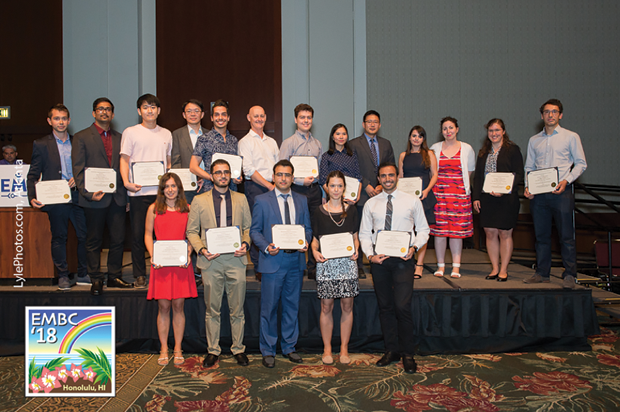
As an incoming PhD student in computer science and engineering at the University of Washington, EMBC 2018 was a fantastic experience to kick-start my studies. First, it provided exposure to the wide array of engineering topics in medicine and biology— from signal processing to imaging to neural and rehabilitative engineering—that I can use as inspiration for research projects. Second, sitting in the numerous paper sessions and getting to hear firsthand from the authors provided a fantastic learning experience that added significant color beyond simply just reading the papers (Figure 1). Lastly, speaking with accomplished academics such as Sergio Cerutti at the IEEE Lunch with Leaders provided the ability to hear important tips and advice for how to forge a career in engineering for biomedical applications. As a result, I would highly recommend EMBC for any incoming Ph.D. student interested in biomedical engineering!
Debsubhra Chakraborty, Nanyang Technological University, Singapore
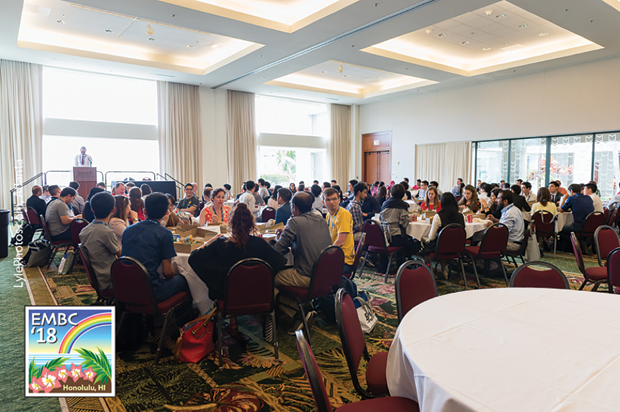
The annual conference of the EMBS obviously requires no introduction—EMBC has been seamlessly bridging the apparently disparate fields of engineering and life sciences for over 40 years now. Thus, I was delighted to be a part of EMBC for the first time in 2018, and the fact that the conference was being held in Honolulu, HI, certainly piqued my interest. The conference was, to say the least, filled with enlightening plenary keynote speeches by Fran Kauffman and John Webster, followed by informative oral sessions and interactive poster sessions. I especially loved the Lunch with Leaders session— we got to interact with the eminent professors and experts of the field—getting valuable insights about future research trends and advancements in the domain (Figure 2). The casual networking sessions among students, researchers, and professors was another highlight of the conference. I definitely am looking forward to attending its next version in Berlin.
Jingzhi An, Harvard-MIT Division of Health Science and Technology, USA
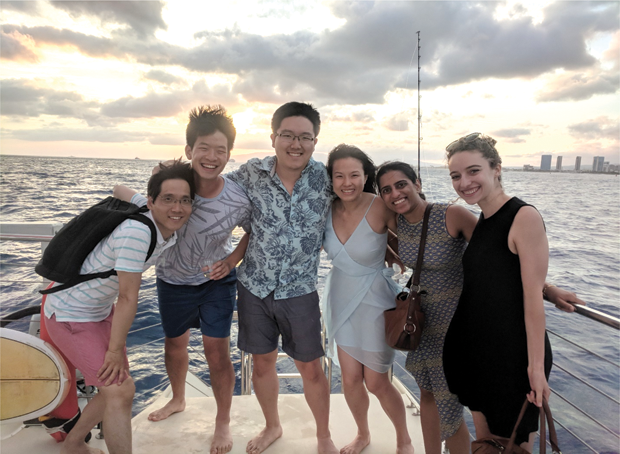
This was my third time attending EMBC in five years as a graduate student. I traveled from Boston with an entirely different cohort of lab-mates from my first time attending the conference in 2015 (Figure 3). The process was familiar, but the new group brought with them a new set of projects representing fresh ideas from our Neuroscience Statistics Research Laboratory (NSRL) at MIT. I also presented a new topic: an image processing pipeline for establishing a new behavioral assay to detect loss of consciousness in rodents. This project is a novel application of the statistical inference techniques I used in my pursuit to design a physiological closed-loop control system for managing medically induced coma in humans. This mixture of novel and familiar experiences is the reason I really enjoy attending EMBC. On the academic side, due to its broad scope, EMBC is an opportunity for me to deepen my understanding of my main research area while also challenging myself to learn about new topics. On the personal side, I caught up with geographically distant friends and colleagues, and I made new friends with whom I hope to stay in touch after the conference. During the Lunch with Leaders for student participants, which I have enjoyed attending at every EMBC, I serendipitously reconnected with an old mentor. Overall, perhaps the gathering of the current and past members of the NSRL best summed up my EMBC experience: a rewarding and enjoyable blend of ideas and people from across space and time.
Bassem Ibrahim, Texas A&M University, USA
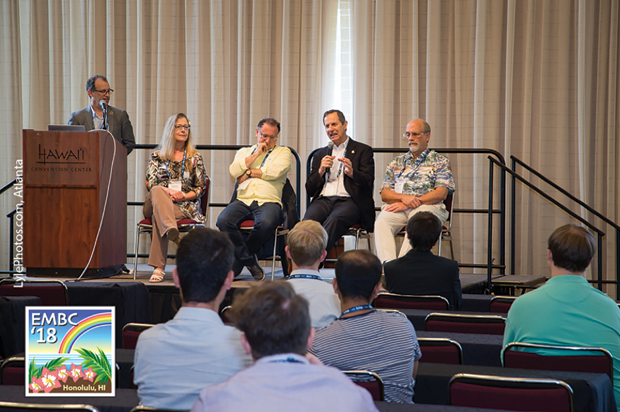
This was my first time at the EMBC, and I hope to repeat it every year. It was a great opportunity for me to attend very useful presentations (Figure 4) about my research interest in wearable physiological sensing and cuffless blood pressure monitoring. I enjoyed the Lunch with Leaders where each leader sits with a group of five students to share his experience and answer students’ questions. During the hour, we talked about the new trends in biomedical engineering, the difference between the academia and industry, and how to be a successful graduate student. The keynote speeches at this conference were extremely inspiring about three unique companies: NeuroPace, Medtronic, and Google Verily. In addition to the technical side, I cannot forget the amazing moments that I spent on the awesome beaches of Hawaii and knowing about the special Hawaiian culture. One of my goals next year is to work hard to submit a new paper for the next EMBC to repeat this wonderful experience.
Zoi Tokoutsi, RWTH Aachen University, Germany
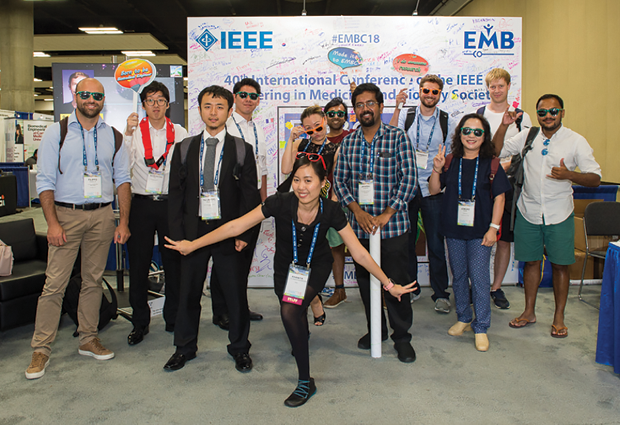
As a Ph.D. student in an interdisciplinary subject bridging computational mathematics and medicine, I have been looking for a conference that is most relevant to my work. I found that at the EMBC! I have had the opportunity to attend exciting presentations by world-renowned researchers in my fields of study. I was positively surprised by how approachable acknowledged scientists were, and I had a number of engaging discussions. While attending the Lunch with Leaders, I had the immense pleasure to be seated along Prof. Chrit Moonen, an expert on focused ultrasound, which is very relevant to my research, and Dr. Lisa Lazareck-Asunta, the EMBS-WIE Representative, and be stimulated scientifically, professionally, and personally by them. EMBC offered an open, inspiring and friendly environment for young researchers to meet and discuss not only with each other, but also with renowned scientists and leaders (Figure 5). It has been an amazing experience, and I am looking forward to EMBC 2019 in Berlin!
Daniel Christopher Sweeney, University of North Carolina, USA
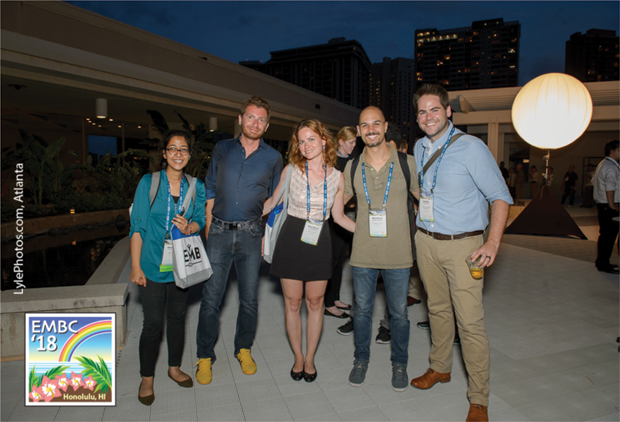
I had a great time at EMBC 2018, and it was an opportunity to meet so many innovators in fields outside my own. This was my first time attending EMBC, and I particularly enjoyed the poster sessions and the conversations I had with my colleagues in the fields of microfluidics and microfabrication, bioelectrics, and microscopy. These technical conversations led to other conversations over meals and potential professional collaborations and future mentorship opportunities. At the Welcome Reception, a photo sparked conversation with friends from universities in Naples and Sweden, which continued over kalua pork that evening and over the following days. I ran into the brother of a colleague at the Student/Young Professional Reception (Figure 6) and shared our aspirations and experiences over a few Hawaiian beers. More technically, the feedback I received at my oral presentation is already advancing my research goals. I am certainly looking forward to attending future IEEE EMBS meetings, and I would like to thank everyone who worked to make this week in Honolulu as profoundly productive and enjoyable as it was.


